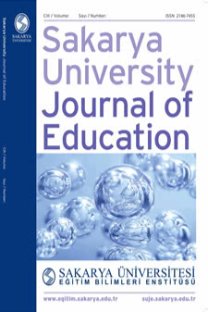Fennema - Sherman Mathematics Attitude Scales: Adaptaition to Turkish Culture
Fennema-Sherman, attitude towards learning mathematics mathematics attitude, scale adaptation
Fennema - Sherman Mathematics Attitude Scales: Adaptaition to Turkish Culture
___
- Aiken, L. R. (1970). Attitudes toward mathematics. Review of Educational Research, 40(4), 551−596.
- Aiken, L. R. (1972). Research on attitudes toward mathematics. Arithmetic Teacher, 19(3), 229−234.
- Aydeniz, M., Cakmakcı, G., Cavas, B., Ozdemir, S., Akgunduz, D., Corlu, M. S., & Oner, T. (2015). STEM eğitimi Türkiye raporu: Günün modası mı yoksa gereksinim mi? [A report on STEM Education in Turkey: A provisional agenda or a necessity?] [White Paper]. İstanbul, Turkey: Aydın Üniversitesi. Bartlett, M. S. (1950).Tests of significance in factor analysis.The British Journal of Psychology, 3 (Part II), 77– 85.
- Blackweir, J. (2016). Attitudes towards mathematics: Development and validation of an online, semantically differentiated, visual analogue scale, Thesis and Coursework of The University of Western Australia.
- Büyüköztürk, Ş. (2013). Sosyal bilimler için veri analizi el kitabı: İstatistik, araştırma deseni, SPSS uygulamaları ve yorum. (18th ed.). Ankara: Pegem Akademi Yayıncılık.
- Di Martino, P., & Zan, R. (2010). ‘Me and maths’: Towards a definition of attitude grounded on students’ narratives. Journal of Mathematics Teacher Education, 13(1), 27–48. http://dx.doi.org/10.1007/s10857-009-9134-z
- Etsey, Y., & Snetzler, S. (1998). A meta-analysis of gender differences in student attitudes toward mathematics. Paper presented at the Annual Meeting of the American Educational Research Association, San Diego, USA, 13−17 April 1998.
- Fennema, E., & Sherman, J. (1976). Fennema-Sherman mathematics attitudes scales: Instruments designed to measure attitudes toward the learning of mathematics by females and males. Journal for Research in Mathematics Education, 7(5), 324−326.
- Felder, R. M., Felder, G. N., Mauney, M., Hamrin, C. E., & Dietz, E. J. (1995). A longitudinal study of engineering student performance and retention. III. Gender differences in student performance and attitudes. Journal of Engineering Education, 84(2), 151−163.
- Johnson, R. M. (2000). Gender differences in mathematics performance. Annual Meeting of the American Educational Research Association, New Orleans, LA, USA.
- Jöreskog, K. G., & Sörbom, D. (1993). LISREL 8: Structural equation modeling with the SIMPLIS command language. Hillsdale, NJ: Lawrence Erlbaum Associates Publishers.
- Kaiser, H. (1974).An index of factorsimplicity.Psychometrika39: 31–36.
- Kanny, MA, Sax, LJ, Riggers-Pieh, TA. (2014). Investigating forty years of stem research: How explanations for the gender gap have evolved over time. Journal of Women and Minorities in Science and Engineering 20(2), 127–148.
- Khine, M. S., & Afari, E. (2014). Psychometric properties of an inventory to determine the factors that affect students’ attitudes toward mathematics. Psychology, Society, & Education, 6(1), 1–15. Retrieved from http://psye.org/articulos/khine.pdf
- LeGrand, J. C. (2013). Exploring gender differences across elementary, middle, and high school students' science and math attitudes and interest (Unpublished doctoral dissertation).
- Leslie, S., Cimpian, A., Meyer, M., & Freeland, E. (2015). Expectations of brilliance underlie gender distributions across academic disciplines. Science, 347(6219), 262–265. http://dx.doi.org/10.1126/science.1261375
- Lim, S. (2012). Using history as context in pre-tertiary Singapore mathematics classrooms: Effects on achievement, motivation, attitudes and anxiety (Unpublished doctoral dissertation). University of Western Australia, Crawley, WA.
- Liu (2003). Developing a Scaletomeasuretheınteractivity of websites, Journal of AdvertisingResearch, June, 207–217.
- Ma, X., & Kishor, N. (1997). Assessing the relationship between attitude toward mathematics and achievement in mathematics: A meta-analysis. Journal for Research in Mathematics Education, 28(1), 26−47.
- F. Mulhern, G. Rae. (1998). Development of a shortened form of the Fennema–Sherman mathematics attitudes scale Educational and Psychological Measurement, 58, pp. 295-306, 10.1177/0013164498058002012
- Neale, D. (1969). The role of attitudes in learning mathematics. Arithmetic Teacher, 16(8), 631−640.
- Ross, V. (2015). More than “a little bit nervous”: Understanding the experiences of young women with anxiety during secondary school. (Unpublished master’s thesis, Queen’s University, Kingston, Ontario).
- Tapia, M. (1996). The attitudes toward mathematics instrument. Paper presented at the annual meeting of the Mid-South Educational Research Association, Tuscaloosa, USA, 6−8 November 1996.
- Tapia, M., & Marsh, G. E. (2000). Effect of gender, achievement in mathematics, and ethnicity on attitudes toward mathematics. Annual Meeting of the Mid-South Educational Research Association, Bowling Green, KY, USA.
- Triandis, H. (1971). Attitude and attitude change. New York: John Wiley & Sons, Inc.
- Wigfield, A., & Eccles, J. S. (2000). Expectancy–value theory of achievement motivation. Contemporary Educational Psychology, 25(1), 68–81.
- Walberg, H. J., & Haertel, G. D. (1992). Educational psychology's first century. Educational Psychology, 84, 6- 19.
- Yıldırım, H. H., Yıldırım, S., & Ceylan, E. (2017) Türkiye Perspektifinden TIMSS 2015 Sonuçları. Türk Eğitim Derneği (TED). Ankara.
- ISSN: 2146-7455
- Yayın Aralığı: 3
- Başlangıç: 2011
- Yayıncı: Sakarya Üniversitesi Eğitim Bilimleri Enstitüsü
Türkiye’de Özel Öğrenme Güçlüğü Alanında Yapılan Çalışmaların İncelenmesi
Bora GÖRGÜN, Macid Ayhan MELEKOĞLU
Namudar İzzet KURBANOĞLU, Berrin Nur ZOR, Sefa YÜCE
Turkish Teacher Candidates’ Perceptions of Native- Speakerism
Futbol Hakemlerinin Öz-Yeterlik Düzeylerinin İncelenmesi
Çağatay DERECELİ, Hüseyin ÜNLÜ, Mustafa Kayıhan ERBAŞ
Mustafa BEKTAŞ, Fatih Selim SELLÜM, Derya POLAT
Fen Bilgisi Öğretmen Adaylarının Bilimsel Süreçte Bilgi İletişim Teknolojileri Kullanımı
Nilgün YENİCE, Fatma CANDARLI, Neslihan YAVAŞOĞLU, Gizem ALPAK TUNÇ
Lise Öğrencilerinin Sayısal Okuryazarlık Düzeylerinin Belirlenmesi: Hendek Örneği
Örgütsel Narsisizm Düzeyine İlişkin Yönetici ve Öğretmen Algıları Sakarya İli Liseler Örneği
